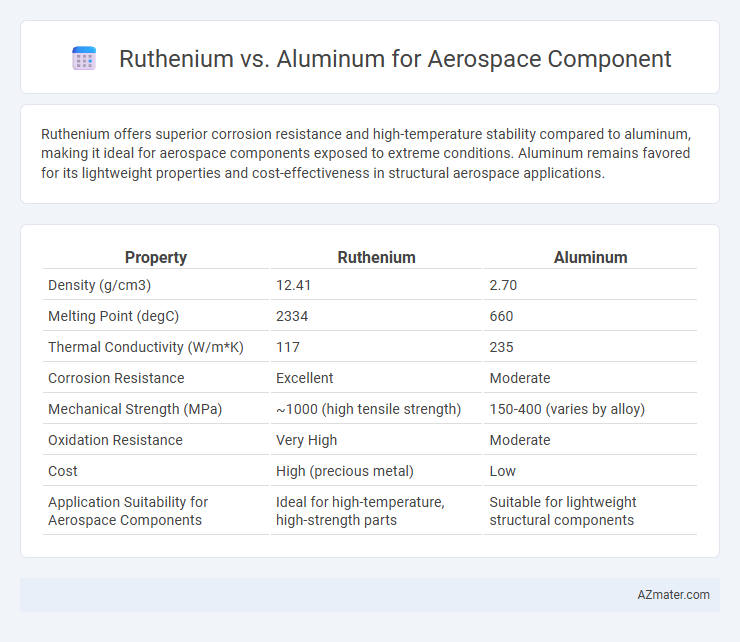Ruthenium offers superior corrosion resistance and high-temperature stability compared to aluminum, making it ideal for aerospace components exposed to extreme conditions. Aluminum remains favored for its lightweight properties and cost-effectiveness in structural aerospace applications.
Table of Comparison
| Property | Ruthenium | Aluminum |
|---|---|---|
| Density (g/cm3) | 12.41 | 2.70 |
| Melting Point (degC) | 2334 | 660 |
| Thermal Conductivity (W/m*K) | 117 | 235 |
| Corrosion Resistance | Excellent | Moderate |
| Mechanical Strength (MPa) | ~1000 (high tensile strength) | 150-400 (varies by alloy) |
| Oxidation Resistance | Very High | Moderate |
| Cost | High (precious metal) | Low |
| Application Suitability for Aerospace Components | Ideal for high-temperature, high-strength parts | Suitable for lightweight structural components |
Introduction to Ruthenium and Aluminum in Aerospace
Ruthenium, a rare transition metal in the platinum group, offers exceptional corrosion resistance, high hardness, and excellent thermal stability, making it valuable for aerospace components subjected to extreme environmental conditions. Aluminum, widely used in aerospace, is prized for its lightweight, high strength-to-weight ratio, and excellent machinability, enabling fuel efficiency and structural integrity in aircraft design. The distinct properties of ruthenium and aluminum influence their application in aerospace, with aluminum predominating in structural parts while ruthenium serves specialized coating and alloying roles to enhance performance.
Material Properties Comparison: Ruthenium vs Aluminum
Ruthenium offers exceptional hardness, high melting point (2334degC), and excellent corrosion resistance, making it suitable for high-temperature aerospace components exposed to extreme environments. Aluminum, with a lower melting point (660degC) and superior lightweight properties, provides excellent strength-to-weight ratio and ease of fabrication, crucial for structural parts in aerospace design. While aluminum excels in weight-sensitive applications, ruthenium's robust mechanical and thermal properties make it ideal for protective coatings and components requiring durability under harsh conditions.
Strength and Durability in Aerospace Applications
Ruthenium demonstrates exceptional strength and corrosion resistance, making it highly durable for aerospace components subjected to extreme environments. Aluminum, while lightweight and offering good strength-to-weight ratio, generally lacks the high-temperature stability and wear resistance of ruthenium alloys. The superior hardness and oxidation resistance of ruthenium make it ideal for critical aerospace parts requiring longevity and mechanical reliability under stress.
Weight Considerations: Lightweight vs Heavy-duty
Ruthenium, a rare transition metal, offers superior corrosion resistance and exceptional hardness but comes with a higher density, making it less ideal for weight-sensitive aerospace components. Aluminum stands out for its lightweight properties and excellent strength-to-weight ratio, making it the preferred choice for structural components where minimizing weight is critical to fuel efficiency and payload capacity. In aerospace applications, aluminum alloys dominate due to their balance of lightweight and durability, whereas ruthenium is typically reserved for specialized heavy-duty coatings or electronic contacts within aerospace systems.
Corrosion Resistance: Ruthenium vs Aluminum
Ruthenium exhibits superior corrosion resistance compared to aluminum, particularly in harsh aerospace environments involving high temperatures and aggressive chemicals. Ruthenium's ability to form a stable oxide layer prevents further oxidation and degradation, enhancing the durability of aerospace components. In contrast, aluminum is prone to pitting and galvanic corrosion unless extensively treated with protective coatings.
Cost Analysis and Economic Impact
Ruthenium, a rare platinum-group metal, significantly exceeds aluminum in raw material cost, making it less economical for widespread aerospace component production despite its superior corrosion resistance and durability. Aluminum's lightweight, availability, and established manufacturing processes offer cost-effective advantages critical for aerospace applications, minimizing production expenses and enabling mass adoption. The economic impact favors aluminum, as its affordability supports scalability and reduces overall project budgets, whereas ruthenium's high price confines its use to specialized, high-performance components where cost is secondary to material properties.
Machinability and Manufacturing Efficiency
Ruthenium offers superior corrosion resistance and high-temperature stability but poses significant challenges in machinability due to its hardness and brittleness, increasing manufacturing time and costs. Aluminum excels in manufacturability with excellent machinability, lightweight properties, and widespread availability, enabling faster production and reduced tooling wear in aerospace component fabrication. Selecting aluminum over ruthenium enhances manufacturing efficiency while maintaining adequate performance for many aerospace applications.
Performance in Extreme Environments
Ruthenium exhibits superior corrosion resistance and maintains structural integrity at temperatures exceeding 1000degC, making it highly suitable for aerospace components subjected to extreme heat and oxidative conditions. Aluminum offers lightweight advantages and excellent thermal conductivity but experiences significant strength reduction above 200degC, limiting its performance in high-temperature aerospace applications. The exceptional durability of ruthenium alloys under intense thermal and oxidative stress ensures enhanced longevity and reliability in aerospace environments where aluminum components may fail.
Sustainability and Environmental Impact
Ruthenium offers superior corrosion resistance and longer lifecycle performance compared to aluminum, reducing the frequency of replacement and associated waste in aerospace components. Aluminum, while lightweight and abundant, requires significant energy for extraction and processing, contributing to higher carbon emissions and resource depletion. The use of ruthenium in aerospace parts supports sustainability goals by enhancing durability and minimizing environmental impact through reduced material consumption and improved recyclability.
Future Trends in Aerospace Material Selection
Ruthenium's exceptional corrosion resistance and high melting point position it as a promising candidate for aerospace components subjected to extreme environments, outperforming aluminum in durability and thermal stability. While aluminum remains popular due to its lightweight and cost-efficiency, emerging aerospace trends emphasize advanced materials like ruthenium alloys that enhance performance in next-generation aircraft and spacecraft. Future aerospace material selection will increasingly prioritize ruthenium's ability to withstand harsh conditions and improve component longevity, aligning with industry demands for sustainability and high-performance engineering.

Infographic: Ruthenium vs Aluminum for Aerospace Component
 azmater.com
azmater.com